Reviews of "Renfield," "Framing Agnes" and "The Moon & Back," as well as a podcast preview, are all in the latest Movies with Meaning post on the web site of The Good Media Network, available by clicking here.



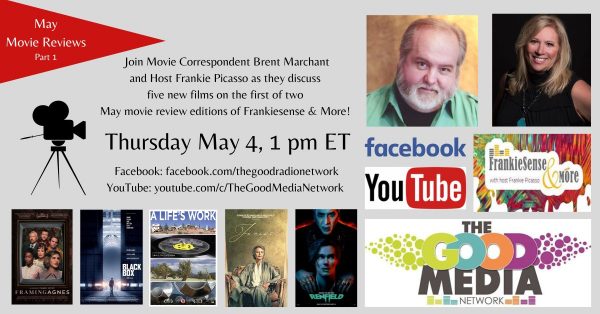

Reviews of "Renfield," "Framing Agnes" and "The Moon & Back," as well as a podcast preview, are all in the latest Movies with Meaning post on the web site of The Good Media Network, available by clicking here.






“The Moon & Back” (2022). Cast: Isabel May, Missi Pyle, Nat Faxon, P.J. Byrne, Miles Gutierrez-Riley, Taiv Lee, Roman Michael, Molly Jackson, Riley Madison Fuller. Director: Leah Bleich. Screenplay: Leah Bleich. Web site.
Where do we turn when the bottom falls out? That’s difficult enough at any age, but what is one to do when going through an impressionable time of life, such as adolescence? The coming of age considerations that teens face are often burdensome enough in themselves. However, when they’re compounded by a significant loss, starting over may seem impossible. Such are the conditions that a devastated young woman must figure out for herself in the new comedy-drama, “The Moon & Back.”
However, when a teenage Lydia (Isabel May) entered high school, circumstances drastically changed as Peter’s health began faltering, eventually leading to his untimely death. It goes without saying that Lydia was devastated. She withdrew into herself, falling into a relentlessly unremarkable holding pattern. And, after a year of this, as Lydia began her senior year, she seemed more lost than ever.
Such is the prologue of this film, told largely through simulated home videotape archives. As the main story opens, Diane tries coaxing Lydia out of her malaise. After all, the time is fast approaching when they’ll need to make some decisions about Lydia’s college plans. Diane initially approaches the subject tactfully, but, given Lydia’s grief-stricken state of mind, she’s ambivalent about continuing her studies, an attitude that worries mom. She wants her daughter to further her education, despite the financial hardships it will place on the household, but she’s met with intractable indifference. Lydia has intentionally put her life on hold, and Diane wonders whether she’ll ever start moving forward again.
Circumstances soon change, however, when Lydia stumbles upon a half-written sci-fi screenplay that Peter had been working on prior to his death. She’s intrigued by the script and decides that making a movie based on this material would make for a fitting tribute to her dad. It’s not exactly the plan that Diane had in mind, but, if it motivates Lydia to start doing something with her life again, she’ll willingly throw her support behind it.
Thus begins Lydia’s experiment to find herself. Having never made a movie before, she’s embarking on a project in which she truly doesn’t know what she doesn’t know. But that doesn’t stop her from launching into this exploration of the unknown. And so, armed with only a video camera, a half-written script, a handful of money and a whole lot of gumption, she sets off on this journey of discovery.
Lydia is by no means alone in this endeavor; she has ample support from a ragtag array of backers who are truly in her corner and want to see her succeed, especially since they know how much this project means to her personally. She receives zealous backing from her high school guidance counselor, Mr. Martin (P.J. Byrne); classmates Simon (Miles Gutierrez-Riley), Josh (Taiv Lee) and Mariana (Molly Jackson); her neighbor, George (Roman Michael); and, of course, her mother. It’s indeed encouraging to see how readily they all rally to her cause, aptly illustrating that the assistance we need somehow manages to materialize when we need it most. And, as events unfold, it becomes apparent that Lydia really needs it.
Enthusiasm aside, Lydia has her work cut out for her on this project. Having no experience as a filmmaker, she has to improvise much of what she does as she goes along. This is further complicated by not having a finished script for the picture, prompting her to figure out where she ultimately wants to take the story. Then there’s the pressure to be true to her dad’s intent, which is considerable, since he never finished the screenplay, leaving her to intuit where she thinks the story should go to fulfill his vision.
What’s more, undertaking a venture like this at a time of life that’s fraught with its own inherent challenges can be particularly daunting. The coming of age process can be difficult enough in itself without the added stress and anxiety that often accompany endeavors like this. And the absence of the one person who one would most likely turn to for advice at a time like this – in this case, Lydia’s dad – can be even more trying. But the fact that the budding auteur is willing to take on all of these challenges simultaneously speaks volumes about just how inherently ambitious she truly is. That’s a big step for someone who not long before had trouble getting off the dime to get on with her life. Indeed, with determination like that, there’s no telling what else she might be able to accomplish – maybe even venture to the moon and back.
The most obvious answer is looking for a way to pick up the pieces and carry on. But, before we can do that, we first have to believe in the notion that such a step is even possible. And, when we’re weighed down by such palpable emotions as grief, longing and despair, mustering up the faith and conviction to foster such beliefs is, at the very least, unnerving, if not overwhelming. Thus, getting past such a discouraging outlook is essential if we ever hope to get our lives back on track, particularly when it comes to employing the conscious creation process, the philosophy that maintains we draw upon the power of our thoughts, beliefs and intents in manifesting the reality we experience. It’s unknown whether Lydia has ever heard of this school of thought, but, if she ever hopes to make something meaningful and fulfilling out of her life, she had better consider it as a means for reaching that goal.
Lydia is starting from a difficult place in this regard. Not only does she not know how to fulfill her objectives, she can’t even envision what they might be. By not knowing what we hope to achieve, we don’t even know where to start, let alone how to reach a desired destination. So the question once again becomes, where do we go from here?
Since the primary purpose of one’s existence is to create it, anyone who is experiencing what Lydia is going through might want to consider that objective as a starting point. In essence, this involves looking for something of a creative nature that will generate a sense of personal satisfaction. It gives us something to believe in and an undertaking into which we can direct our energies, and virtually anyone who has embarked on such an endeavor can testify to that effect. The key, of course, is finding such a project and being willing to pour ourselves into it, a practice that generates the beliefs necessary to make it possible.

That’s precisely what happens for Lydia when she finds her dad’s unfinished screenplay. The discovery sparks her interest in multiple ways – it gives her something to focus on, it gives her something to which she can provide a sense of completion and it gives her a way to pay tribute to Peter, something she needs to do to get past her grief and provide a much-needed sense of closure. Its inherent artistic nature also embodies the very notion of creativity, what lies at the core of the conscious creation process. By tackling this project, Lydia has a valuable opportunity to get back in step with her purpose for living, to rejoin the existence of which she is a part.
It helps immensely that she has so many backers in her corner, too. Their support provides validation for this undertaking, not only as a means to honor her father, but also to provide direction for getting her life back on track and infusing it with a much-needed sense of purpose (one that could even lead to the development of a vocation, giving her the focus that has been so lacking in her life for a long time). It comes at a significant time in her life, too, considering the often-challenging conditions that arise when one goes through the coming of age process. Her movie project serves as something of a buffer against those considerations, helping her to grow and mature into adulthood and to keep petty adolescent distractions at bay that might otherwise consume a disproportionate amount of her consciousness and attention.
Perhaps most importantly, though, this venture enables the healing process to go forward, something Lydia desperately needs. It enables her to adopt a new perspective on her reality, a change that allows her to employ a new overall outlook on life, one that carries the potential to radically shift the nature of the existence she experiences. This is not to suggest that putting her old life behind her requires her to erase memories and emotions about her father; rather, it means altering her frame of mind so that she can put that portion of her life in a new context, one that retains the best of that time without preventing her from moving forward into a new way of living. As the conscious creation process maintains, everything is in a constant state of becoming, but that evolution can be thwarted when we implement beliefs that intentionally seek to derail that process, as she has been doing for some time. It’s nice to see that she’s found a way to eliminate that stagnation, one that has restored her forward progress, made it possible to contextualize her grieving and allowed her to once again have some fun in her life. And all it took was implementing a little creativity.
Coming of age can be difficult enough in itself, but, when we lose someone who has been a source of valuable guidance in the midst of that process, the result can be shattering. Under conditions like that, it can be easy to lose one’s way. So it is for Lydia, who needs to chart a new course for herself. And, when she does, she learns that an important part of coming of age means letting go of what no longer serves us and being willing to strike out on our own – even leaving behind the source of inspiration who helped us get so far. Writer-director Leah Bleich’s charming comedy-drama provides viewers with a refreshingly distinctive take on material typical of this genre, providing just the right amount of heart tugs but without overdoing it, all the while serving up both laughs and serious moments that successfully avoid the clichés often found in stories like this. The narrative manages to stay on track quite well, despite a few meandering lulls, keeping the storytelling crisp and economical. And, given the excellent, incisive, edgy character development here, this offering strikes me very much as being the movie that “Lady Bird” (2017) was striving to be but could never quite get right. Indeed, “The Moon & Back” is a fun, pleasant, enjoyable little diversion, but it’s by no means a lightweight, just what a film of this stripe should be.
Unfortunately, finding “The Moon & Back” at the moment may be a little difficult. The picture has primarily played the film festival circuit, and news of a general distribution in theaters and/or online has not yet been forthcoming. Nevertheless, viewers interested in this offering would serve themselves well by catching this delightful charmer if a screening opportunity were to present itself, especially in communities that stage film festivals.
No one wants to endure a devastating loss. Such tragedies are difficult enough in themselves, and envisioning what comes in their aftermath can be frightening, both in terms of their impact and what might be involved in going through them. Yet situations like this are one of the inevitabilities to which we’re all subjected at some point in our lives. We may not like having to undergo them, but they nevertheless provide us with an opportunity to learn how to respond to adversity. They test our ability to cope. They test our resiliency to bounce back from these situations. And they teach us how to be creative and flexible in overcoming hardship. There may even be the proverbial silver linings buried within them. No matter what results, however, they afford us the chance to grow as individuals, and that can prove exceedingly valuable in the long run, a heartfelt gift bequeathed to us from those who have left us, one that can help us to become who we were meant to be.
Copyright © 2022-2023, by Brent Marchant. All rights reserved.
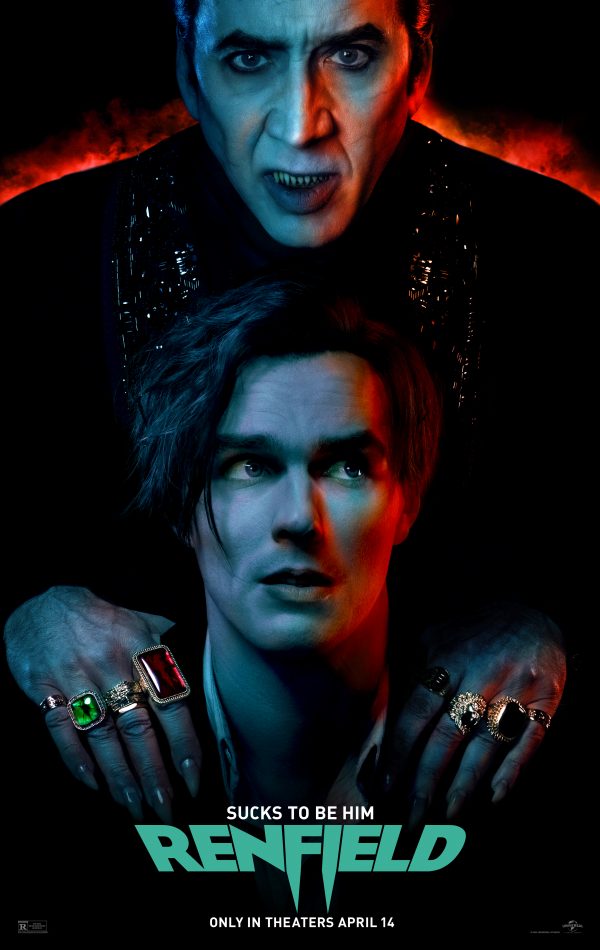
“Renfield” (2023). Cast: Nicholas Hoult, Nicolas Cage, Awkwafina, Ben Schwartz, Shohreh Aghdashloo, Adrian Martinez, Brandon Scott Jones, Camille Chen, Bess Rous, Jenna Kanell, Danya LaBelle, Rhonda Johnson Dents, Christopher Matthew Cook, Michael P. Sullivan, Rosha Washington, James Moses Black. Director: Chris McKay. Screenplay: Ryan Ridley. Story: Robert Kirkman. Web site. Trailer.
No one likes to go through life without access to one’s personal power. Doing so leaves us vulnerable to being taken for granted and under the thumb of others who care only about themselves and have no regard for us. If allowed to continue unchecked, such circumstances can become toxic co-dependent relationships that are difficult to escape, potentially trapping us in perpetuity. So how do we extricate ourselves from such situations? That’s the underlying focus of the new campy horror romp, “Renfield.”
For a seeming eternity, former real estate lawyer Robert Montague Renfield (Nicholas Hoult) has been a virtual slave to his powerful master. Having journeyed from his native England to Eastern Europe to close what he hoped would be a lucrative land deal to support himself and his family, Renfield approached his prospect with great gusto and enthusiasm, only to have the proposal take a drastic left turn when the target extends to him a proposal of his own – immortality. The seductive allure of that possibility wins over the young attorney, despite the strings that come attached with it, the most significant of which is agreeing to become a devoted servant to his new boss, an offer that Renfield readily accepts. But, despite what he’s been promised, Robert has no idea what he’s getting himself into given who his new master is – Dracula (Nicolas Cage).
In the years that follow, Renfield is introduced to high society and influential people. But, in exchange for this, he’s saddled with the responsibility of attending to all of his vampiric boss’s needs, such as going out every day and securing Dracula’s “dinner.” The routine gets old over time, and Renfield grows dissatisfied. He hasn’t seen his wife and child in ages, and the possibility of that happening grows progressively less likely. He also feels stuck in a meaningless existence with no hope of personal fulfillment. Nevertheless, he begins contemplating changes in his life, even though striking out in a new direction proves far more difficult than expected, keeping him trapped for decades.
After years of this, an event occurs that could change Renfield’s fortunes. Dracula is seriously injured when the night stalker is unexpectedly exposed to daylight, nearly causing his demise. His severely weakened condition requires intensive care to restore his health, and, because of this, he becomes more dependent on Renfield than ever. However, given the Count’s depleted state, he must remain in seclusion most of the time, holed up in an abandoned hospital in New Orleans, the duo’s adoptive new home. That convalescent isolation actually frees up Renfield’s routine somewhat; as long as he satisfies his master’s basic needs, there’s little that Dracula can do to keep tabs on his servant’s movements, enabling him to pursue his own interests, most notably changing his life to better suit what he wants from it.
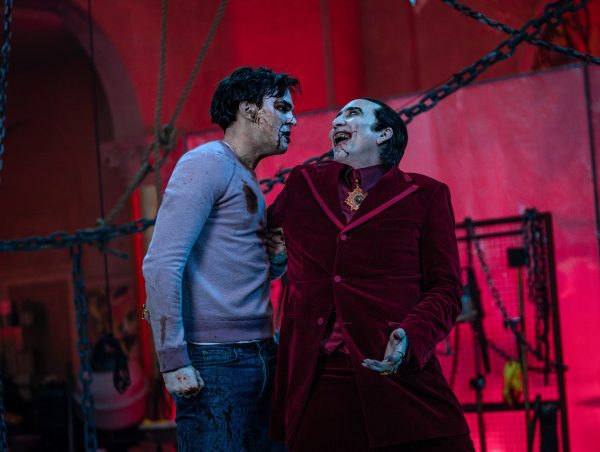
Renfield decides to enroll in a support group helping individuals who are wrestling with the challenges of toxic co-dependent relationships. This self-help program proves quite enlightening, especially when the group’s facilitator (Brandon Scott Jones) informs his organization’s newest member that the key to overcoming situations like this is to take steps to take back one’s sense of personal power. It’s a revelation akin to a proverbial lightbulb going off over Robert’s head, and so he starts taking steps to that end – clandestinely getting his own apartment, covering his walls in motivational posters, saying his daily affirmations and buying himself a more cheerful, upbeat pastel wardrobe. It’s all a far cry from the dour, dismal lifestyle he’s been accustomed to living for so long.
But, as Robert soon discovers, there’s more to taking back one’s power than simply acquiring transformative surface trappings and mouthing the words that go with these ideas. It’s a process that requires deeds as much as thoughts. He gets a chance to put that notion into practice when he unwittingly becomes embroiled with a powerful New Orleans mob family, the Lobo clan, particularly its chief braggart muscle man, Teddy (Ben Schwartz), and oily, glamour puss matriarch, Bellafrancesca (Shohreh Aghdashloo). When the Lobos stage a raid on a questionable nightspot, Renfield is present when the hit goes down and immediately springs into action to protect the club’s patrons, innocent bystanders caught in the crossfire. He also offers support to police authorities when they arrive on the scene, particularly an idealistic officer, Rebecca Quincy (Awkwafina). And, when all is said and done, Robert and Rebecca forge a solid connection based on both their intense interest in law enforcement and, to a lesser degree, one another.
The situation becomes further complicated when the Lobos go in search of this mystery man who thwarted their raid, a pursuit that eventually leads them to the abandoned hospital and to Renfield’s boss. When Dracula learns who they are, why they’re there and what Robert has quietly been up to, the Count feels betrayed. However, upon meeting the mob family, he also finds new allies to both seek out the traitor Renfield and to join forces with them in implementing his plan to take over both New Orleans and the world beyond.
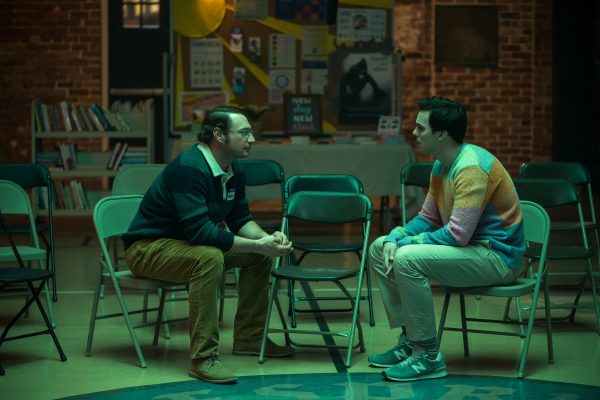
Before long, Robert and Rebecca get wind of what’s going on, and they realize what they’re up against. In addition to the alliance between Dracula and the Lobos, the enemies have the support of a police department that’s rotten to the core. Rebecca is already on the outs with the agency given her relentless investigation into the death of her father, a fellow officer. And, now that she’s taken a more aggressive posture to take down all the bad apples, she’s put herself and her sister, Kate (Camille Chen), an FBI agent, in jeopardy.
With circumstances like these, the deck is truly stacked against Robert. But conditions like these are in many ways ideal to prompt him to take action to take back his power. And, with a sidekick like Rebecca to offer ample inspiration, he’s got the means to put these practices into play. But will it be enough against the combined forces of Dracula, a powerful mob family and a monolithically corrupt police department? That’s a lot of power to be taken back.
However, this is not to suggest that nothing can be done about these situations. As the support group facilitator astutely observes, those who feel persecuted by their co-dependent relationships can change the game by taking back their personal power, something they often don’t realize they’ve given away (and voluntarily at that). Admitting this is half the battle, and believing that we can do something about it is the tonic. Of course, that belief component is crucial given the role it plays in manifesting the reality we experience as a result of the conscious creation process, the philosophy that makes this outcome possible. It’s unclear whether those seeking to make a change are aware of this school of thought, but those who opt to give it a try may well find themselves pleasantly surprised at the result.
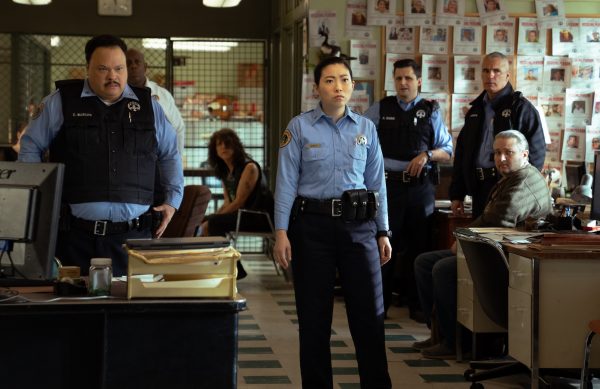
As anyone familiar with this thinking knows, beliefs are powerful and persistent tools. But, if we choose to give away that power to a co-dependent relationship partner, as Robert has done, it can leave us without the wherewithal to materialize what we want for ourselves. This is because all of our power and beliefs are focused on fulfilling the wants and needs of others, implicitly placing us in a secondary position. In the end, how fulfilling can that be? It’s a painful lesson that the protagonist has come to learn over many years, and he desperately wants to rectify that. Unfortunately, that may not be easy given how this precious resource has been drained from him in light of the power and persistence of the beliefs that have made this outcome possible.
This is not to say that Renfield can’t get his power back. However, he must believe in the possibility and take steps to realize its manifestation, first with his beliefs and intents and then with his actions. He’s obviously up against a lot to achieve that goal, but those forces can benefit Robert by prompting him to galvanize his convictions, to make sure he’s focused on and committed to attaining his objective. That can go a long way to making it happen.
A common misconception where co-dependency is concerned is that it’s limited to the dynamics associated with close personal relationships, be it with romantic partners or family members. But, in essence, it can also be tied to anything that prompts us to give away our personal power, functioning almost like an addiction. And, from that, it’s apparent that Robert is not the only one in the film afflicted with this condition.
For example, in order for the Lobo family to maintain its criminal empire and its control over the residents of New Orleans, its members have had to buy into a way of life in which they’ve sacrificed their personal power for the sake of their greed-driven goals. This has meant, of necessity, that they’ve had to accept violence, killing, mayhem and other similar atrocities as the norm, regardless of how they might affect them personally. It’s a huge trade-off that they’ve been coerced into making as a means to pursue their objectives and maintain their status.
Similarly, Dracula has had to do the same in order to live the life of a vampire. He’s had to give up being able to go outside during the daytime. He’s had to make sure that he has access to a steady supply of fresh blood for feeding. And he’s had to accept the consequences associated with failing to live up to these conditions. This choice has rendered him powerless against living his life any other way. In essence, he, too, has given away his personal power to fulfill this ambition.

Then there’s the police department, which has made a comparable choice of its own. To benefit from the perks and payoffs that come from cooperating with organized crime, its high-ranking officers, such as Rebecca’s boss, Capt. Browning (James Moses Black), have compromised themselves to accommodate their partners in crime (literally). This, in turn, has alienated its virtuous staff members (and probably the citizens of New Orleans), leaving authorities to continually figure out ways to sustain themselves, a task that undoubtedly calls for them to routinely pour their energies into maintaining their position of power, a significant drain on this precious resource.
The sad part in all this is that none of the Lobos, Dracula nor the police fundamentally realize what they’ve gotten themselves into. By having to continually shore up their respective positions, they’re continually investing their power in simply maintaining the status quo. That lack of awareness and outpouring of power, in turn, have provided Robert and Rebecca with a valuable weapon against them – the ability to channel their own power into combatting what is becoming an innately dwindling resource, despite the combined forces that have arisen as a result of their unholy alliance. Who do you think is ultimately going to win that battle?
From the foregoing, the benefits of taking back one’s personal power should be obvious. But, as this film also illustrates, what often seems obvious to outside onlookers isn’t always readily apparent to those caught up in dicey situations like this. That’s why assessing and understanding our beliefs is so important, especially when it comes to the management of that power. If we remain oblivious or unconcerned, we run the risk of giving it away, leaving us unable to manage our affairs, particularly those where the input of that resource is important to fulfilling the objectives we hope to achieve. Robert and Rebecca understand this, and we’d be wise to follow their example.
I must admit that I had some doubts about this one going in. Those who know me are well aware that I’m not a huge fan of horror flicks (unless they’re smart horror or campy comedic romps). But director Chris McKay’s refreshingly humorous take on the Prince of Darkness mythology as told through the eyes of his longtime personal assistant pleasantly surprised me. As a melancholic soul who’s looking to get more out of life than the perpetuation of his unfulfilling tenure as a glorified go-fer, Renfield seeks to change his destiny, a sentiment that many of us can probably relate to. What I found most intriguing about this film is the way it successfully (and hilariously) merges the personal growth/self-help theme in a horror flick context, a brilliant fusion that works amazingly well. To be sure, considering the story’s horror roots, there’s plenty of blood-dripping gore as this yarn unfolds, but it’s all presented with a delightfully whimsical, albeit macabre sense of play, especially in its exceptionally well-choreographed, over-the-top campy action sequences, segments reminiscent of pictures like “The Kingsmen” and “Deadpool” franchises. The narrative also features ample sendups of the self-help/personal growth community, sequences that deliver big belly laughs at the expense of New Age dilettantes who believe that simply reciting a mantra will somehow lead to profound universal enlightenment.
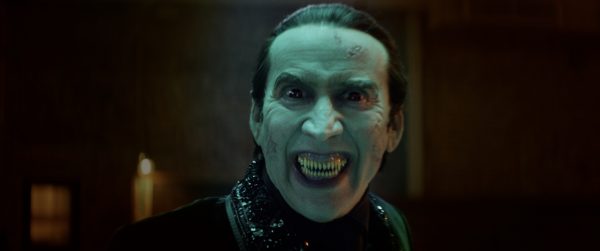
Admittedly, the pacing lags in a few spots, and the meshing of the story threads could have been handled a little more deftly at times. Nevertheless, despite these modest missteps, the laughs are definitely in huge supply here, thanks in large part to the film’s excellent cast, including the fine performances of Hoult as the lost but transformation-minded milquetoast and Aghdashloo as the cheesy mob matriarch. But the one who really steals the show here is Cage, who turns in his best work in years (perhaps even of an award-worthy caliber), memorably embodying the character of Dracula and genuinely making it his own, much like what Michael Keaton did with Beetlejuice and Ryan Reynolds has done with Deadpool. “Renfield” is truly a lot of fun, presenting a skillful blend of substantive, deceptively nuanced material wrapped up in a vehicle where such content is least likely expected. So go sink your teeth into this one; you’re sure to have a bloody good time. The film is playing theatrically.
Freely giving away something that’s so vital to the functioning of our daily lives can carry grave consequences, outcomes that we often can’t see or aren’t even aware of until it’s too late. And, when this practice is allowed to settle in and get cozy, reversing it can be exceedingly difficult. But, considering what’s at stake, it would behoove us to make the effort to get it back before there’s no hope of retrieving it. As something that’s the lifeblood of our existence, we can’t afford to recklessly dispense it. Considering what we’re potentially giving up by doing so, we stand to lose too much – and that would surely leave us in the lurch, where no amount of self-help practices can help us get it back.
Copyright © 2023, by Brent Marchant. All rights reserved.
Tune in for the latest Cinema Scribe segment on Bring Me 2 Life Radio, beginning Tuesday April 25, available by clicking here. You can also catch it later on demand on Spreaker, Spotify, Apple, iHeartRadio, Google Podcasts, Castbox, Deezer, Podchaser and Jiosaavn.
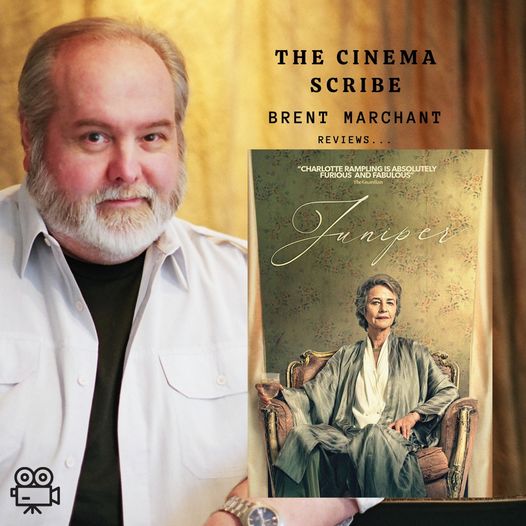
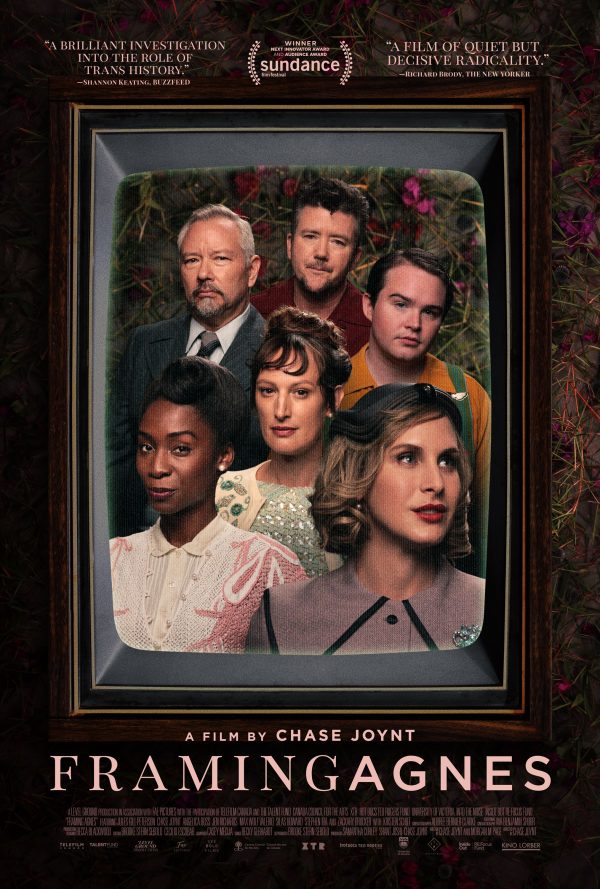
“Framing Agnes” (2022). Cast: Chase Joynt, Zackary Drucker, Jen Richards, Angelica Ross, Silas Howard, Max Valerio, Stephen Ira, Jules Gill-Peterson. Archive Footage: Christine Jorgensen, Carmen Carrera, Laverne Cox, Katie Couric, Joan Rivers, Mike Wallace, Dr. Harold Garfinkel. Director: Chase Joynt. Screenplay: Chase Joynt and Morgan M. Page. Web site. Trailer.
Consequently, those who have sought to pursue their unique identities as members of transgender society have largely received short shrift. To be sure, their inclusion in LGB society may have helped to promote tolerance, acceptance and the promotion of civil rights for these individuals, but has it done the same for encouraging understanding of what trans persons want, who they are and what their community stands for?
Some would contend (and rightly so) that many in transgender society have only started to come above board in their own right over the past few years, and their recognition as a separate, distinct community is a comparatively recent development. However, it could also be argued that this may never have happened were it not for the pioneering (albeit quietly understated) efforts of transgender community members and their supporters who have sought to validate their existence, culture and identity. Those courageous individuals laid the foundation to make this possible, and the purpose behind this film is to recognize those efforts in helping to bring these advances into being.
“Framing Agnes” is a bold, innovative attempt to both chronicle the history of the trans community and to depict what its members experienced personally as its and their stories unfolded. This is accomplished through an inventive collection of archive footage of an early researcher in this field, re-creations of interviews with research subjects (portrayed by a cast of all trans performers), observations of those performers regarding their views on the present-day status of their community and the insights of a noted trans writer/historian. This compilation makes for an enlightening, eye-opening watch, one that sheds valuable historical and contemporary light on an often-misunderstood segment of society.

That misunderstanding most likely began in 1953, when American Christine Jorgensen (1926-1989) returned home from Denmark after undergoing what was one of the first successful gender reassignment surgeries. The former George Jorgensen had hoped to discreetly slip back into the US and live a quiet life. However, when she arrived at New York’s LaGuardia Airport, she was met with a throng of media hounds who paid her more attention than the Danish royal family, who were aboard the same flight. Jorgensen immediately became a celebrity, but her story was treated with titillating sensationalism, limiting her ability to be herself and to help accurately educate the public about the transition she had undergone. Because of this, she was unable to earn a living by doing anything other than making public appearances, a path that eventually led her to become a singer, stage actress and night club entertainer. She also became the de facto poster child for her people, unwittingly setting the standard that much of society drew upon in looking at trans community.
While Jorgensen helped put the transgender community in the public eye, her experience was anything but typical of what she and others like her had hoped would come out of it. The sensationalistic treatment accorded her became what the public expected when it came to writing and reporting on this subject. But, for many of those who were considering the transition option at that time, this is not at all what they wanted. They saw these prospective experiences as private matters to be handled with tact and discretion. They saw themselves in need of undergoing treatment for what they viewed as “a mistake of nature,” not as an invitation to be treated like a carnival side show act. However, with the risk of such cheap, tawdry exploitation always hanging over them, they wanted no part of it and didn’t always know where to turn – and to whom – to get genuinely meaningful guidance.
This situation caught the attention of researchers at UCLA in the early 1960s. Led by Dr. Harold Garfinkel, these investigators wanted to learn more about gender reassignment prospects, including their reasons for pursuing this treatment and their feelings about living life as transgender individuals. And so studies were launched to interview subjects on this topic and to help them get the assistance they needed to realize their goals, such as obtaining access to hormone therapy treatments in advance of any surgeries that might have been performed.
The findings of those studies were compiled, but they essentially disappeared for many years. However, when transgender community historians like Jules Gill-Peterson began searching for these materials, not only did they find interview transcripts, but they discovered a wealth of documents and other evidence of these studies, most of it perfectly preserved. Almost overnight, an extensive history of the early days of transgender research surfaced, opening a door to investigations of the subject that had been thought lost for good.

So who were these interview subjects, and what did they bring to the research? That’s much of what this film focuses on. It introduces viewers to six individuals who took part in the study through re-creations of their interviews. But, instead of presenting these conversations in a clinical setting, they’re staged through a simulated period piece black-and-white TV talk show (a la The Mike Wallace Interview) with the program’s host (Chase Joynt) serving as a surrogate for study leader Harold Garfinkel. The host questions the subjects about an array of topics, including their experiences prior to and after their transitions, the challenges they faced throughout this process, what was behind their decisions to move forward with the change, how these events have affected their lives and feelings about themselves, and what they’ve experienced in the wake of their transformations.
As the movie’s title suggests, the principal interview subject is a trans woman named Agnes (Zackary Drucker), whose presence pops up repeatedly in the research papers. As the story goes, Agnes was anxious to gain access to the hormone treatments and surgical practices that are integral to the transition process, neither of which were readily available at the time for a variety of reasons. Agnes was so determined, in fact, that she allegedly lied her way into obtaining the procedures she needed. However, receiving these treatments is essentially all she wanted out of this, the means to get on with living the kind of life she had envisioned for herself. And this reasoning is believed to account for her virtual disappearance after her transformation, almost becoming a sort of urban legend within the transgender community. Nevertheless, the interview transcripts show that she was a real individual and that she shared her story as part of the study, an experience that proved quite revelatory in the annals of trans community history.
Agnes was not alone, though. There was also Barbara (Jen Richards), who spoke candidly about what she underwent both before and after her transition, particularly in terms of society’s rigid gender role expectations for both trans individuals and those who willingly accepted their birth genders; and Georgia (Angelica Ross), an African-American trans woman who spoke about what it was like for a person of color to go through this at a time when she and others like her were also wrestling with the challenges of the Civil Rights Movement; and Denny (Silas Howard), who, like many individuals in the early days of the trans movement, sought to have his community’s own identity recognized in itself and not just as a specialized adjunct arm of the gay community, a challenge that continued long after the trans movement’s initial establishment; and Henry (Max Valerio), a trans male who sought to establish his identity at middle age; and Jimmy (Stephen Ira), a transgender teen from rural America whose exceptionally open-minded parents (for the time) arranged for him to see specialists to help him explore transition options when most of their peers wouldn’t even consider talking about the possibility, particularly where their children were concerned.
These stories reveal a rich, eye-opening tapestry of conditions and circumstances that the pioneers in the transgender community experienced as a result of their racial backgrounds, chronological ages, motivations for undergoing the process, personal backgrounds and various other considerations. Indeed, the uncovering of their experiences through the interview sequences clearly illustrates that these individuals were far different from what many in society thought about them then (and, to a certain extent, even now). Misconceptions about what supposedly characterized the members of this community are largely swept away. Revelations about the everyday life dealings that they, like other members of society had to contend with, rise to the surface, showing that their lives truly weren’t as inherently “foreign” as many of the uneducated might have thought they were. And the notion that all trans individuals were members of an intrinsically monolithic community with a pervasively uniform mindset proved to be a myth that wasn’t supported by this evidence.
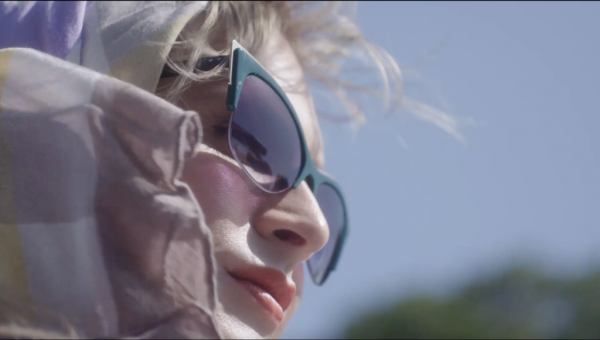
The viewpoints of the actors portraying these figures shed additional light on these matters. Through contemporary interviews with the actors when out of character, viewers learn what they think about the present-day state of the trans community, particularly the ways it has changed since the 1950s and the ways in which it’s still the same, especially when it comes to how those on the outside continue to view it. They, like many community activists, discuss how trans individuals want to be viewed for the individuals that they are and not just as a specialized subset of the larger sexual minority with which they’ve traditionally been associated. These views are further backed up by those of researcher Gill-Peterson, who points out that the widely held fallacies of those who are unfamiliar with the community are no longer true – and never really were to begin with.
The various components that have gone into making up the content of this film may seem like an unusual cinematic combination. Yet, when one considers the information and impressions that they impart collectively, they paint a picture that provides a clearly defined, decidedly different view of what has long been erroneously held by much of society at large. In that way, this documentary makes a powerful statement aimed at changing the hearts and minds about what many of us believe to be true about the nature of a unique community that’s simultaneously different from, and yet also very much like, the rest of the overall society of which it is a part.
The key word in that last sentence is “believe,” for it has the power to define the parameters of what supposedly delineates the character of an entire segment of society, both among those looking at it from the outside, as well as among those on the inside looking out. Beliefs of any kind can indeed become entrenched, thanks to their innate persistence and power, both of which eventually possess the means and momentum to set the limits, impressions and character of the subject matter in question, including something as large as an entire segment of society, especially when enough of us buy into their seemingly inherent validity. Changing these beliefs is always possible, but their mutability can be difficult to adjust once they firmly take root, as the experience and history of the trans community so clearly illustrate.
Such outcomes are the product of the conscious creation process, the philosophy that maintains these intangible resources shape the world around us. Many of us may not be aware of this school of thought, but the output that comes from this is all around us to see, and its entrenchment can become so imbedded that it’s hard to envision things being any other way. And, in the case of society’s outlooks on the nature of the trans community, this has often been just as true among those within it as it was among those on the outside. Insiders may not have wanted this to be the case, but, when they looked around and saw what was surrounding them, it may have often been difficult for them to think otherwise.
That’s why the dissemination of the findings from the UCLA study and this film are so important. Both shine a bright light on the long-held misconceptions about the trans community and how these newly revealed contrary views have been part of its nature and culture from the beginning, even if not widely known. This information presents revelations that could act as the seeds of new beliefs, notions planted in the collective consciousness that yield new ideas among both trans individuals and those on the outside. And we all know what can happen when such new beliefs take root and become established.

The emergence of new views of the transgender community in recent years has done a lot to help distinguish it as its own segment of society, even as one separate from the LGB community from which it has long been associated. That’s important – and empowering – to a group of individuals who have sought to overcome their fears and limitations and seek recognition for the intrinsic inclusivity to which they’re entitled. And this film does much to bolster the community’s optimism and enthusiasm on this front, as well as its efforts to support initiatives to help bring about the fulfillment of its objectives. To be sure, the examples offered up here can go a long way toward shifting perspectives and what may ultimately stem from them.
Anyone who believes that he/she has a good handle on understanding a community’s culture and sensibilities is bound to have his/her eyes thrust wide open by this thoughtful, inventive documentary. In creating this offering, the filmmaker seeks to enliven the little-known life experiences of mid-20th Century transgender pioneers (like the title character) and how they blazed trails for those who followed, particularly in terms of being themselves, questioning society’s rigid gender role expectations, and managing their transitions in conjunction with other life challenges, such as racial equality. The mix of narrative components used for exploring these matters makes for an intriguing, enlightening watch, one that moves along at a refreshingly brisk pace thanks to its astute observations and economical 1:15.00 runtime. To be honest, though, as informative as the talk show sequences are, the use of this storytelling device feels somewhat contrived (if not more than a little gimmicky), despite the depth of the revelations to come out of them. Still, there’s ample food for thought packed into this 2022 Sundance Film Festival NEXT Innovator Award winner, much of it illuminating about both this diverse community and the notion of gender itself, regardless of one’s personal leanings.
It’s often been said that one should not judge a book by its cover. That’s wisdom we should all heed, especially when it comes to judging others and our impressions of them. As this documentary so effectively illustrates, there’s a good chance we might well get it wrong, and that misconception could easily persist for a long time, causing who knows how much damage in the process. Thankfully, this film shows how we can overcome that pitfall and approach our assessments with an enlightened new outlook. And, if we were all to employ that notion, there’s no telling what kind of transformation could result.
Copyright © 2023, by Brent Marchant. All rights reserved.
Tune in for the latest Cinema Scribe segment on Bring Me 2 Life Radio, beginning Tuesday April 11, available by clicking here. You can also catch it later on demand on Spreaker, Spotify, Apple, iHeartRadio, Google Podcasts, Castbox, Deezer, Podchaser and Jiosaavn.

Reviews of "Juniper," "A Life's Work" and "Black Box" are all in the latest Movies with Meaning post on the web site of The Good Media Network, available by clicking here.

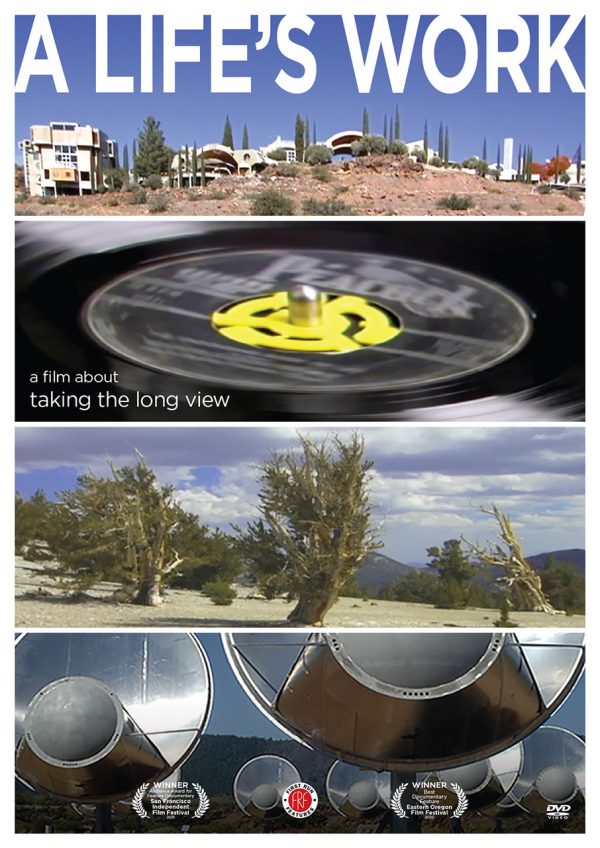
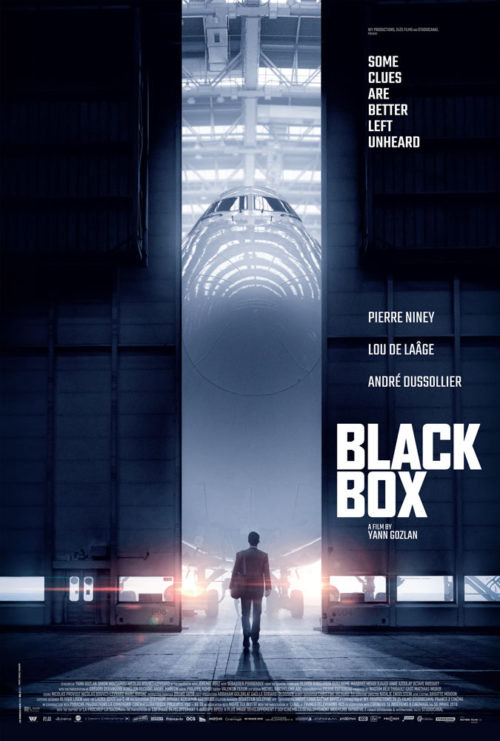


“Juniper” (2021 production, 2023 release). Cast: Charlotte Rampling, George Ferrier, Marton Csokas, Edith Poor, Cameron Carter-Chan, Tane Rolfe, Carlos Muller. Director: Matthew J. Saville. Screenplay: Matthew J. Saville. Web site. Trailer.
With summer vacation approaching, though, Robert is forced into addressing having his son around for the next few months. However, as Sam prepares to leave school and return home to his family’s farm in rural New Zealand, he learns that there’s going to be an unexpected visitor staying with him and his dad: His aging grandmother, Ruth (Charlotte Rampling), a prickly, salty-tongued former war correspondent. Having suffered a severe broken leg that has seriously hampered her mobility, she needs intense care as she convalesces, so she travels to New Zealand from her home in England to recover.
To say that Ruth is not easy to get along with is indeed an understatement. She’s fiercely independent, swears like a sailor and drinks like a fish, consuming nearly a full bottle of gin daily. She’s cooperative only when she needs to be, and she’s often a handful for her nurse, Sarah (Edith Poor), who provides (or attempts to provide) full-time care. Ruth is not especially thrilled about these arrangements, but, given her health, she doesn’t have much of a choice. She goes along with it, but she doesn’t hesitate to make her displeasure known or to bark out orders when she wants something.
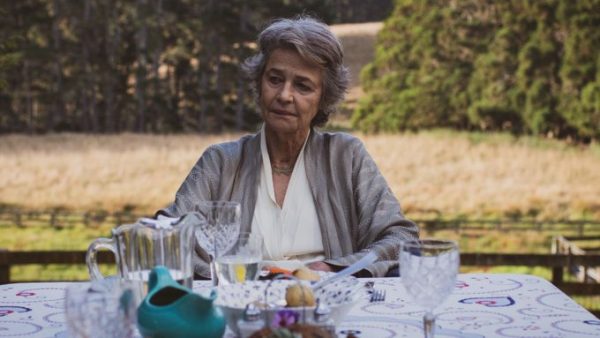
What’s most problematic about these circumstances is that Sam barely knows his grandmother. Even her own son, Robert, doesn’t know or understand her well. Sam and Robert essentially have arm’s-length relationships with Ruth, compounding the emotional distance that already exists between father and son. And no sooner do the three of them settle in for the summer when Robert drops a bombshell: He’s leaving to go to England to settle his mother’s financial affairs, a task that he claims is necessary for her fiscal well-being, not to mention that of his own household. (Despite the family’s sprawling family farm, it’s suggested that the Stevenson family’s finances aren’t in the greatest shape and that, with Ruth’s advancing age and no other apparent heirs on the horizon, Robert stands to inherit what seems to be a sizable sum.) However, as Robert makes this trip, Sam is going to be left in Ruth’s company, with only Sarah present to serve as a buffer between them. Sam’s also expected to assist with Ruth’s care, something that he strongly resists but that both Robert and Sarah insist he become involved in.
Given their respective well-established personalities, Sam and Ruth get off to a rough start. He’s put off by her stern demands, especially when she’s left alone in his care when Sarah handles tasks like running errands. He’s also somewhat appalled by her confrontative outbursts, both with him and with well-meaning others who appear to have her best interests at heart. But, in response, Sam doesn’t hesitate to make his discontent known, either, speaking his mind when he believes Ruth goes too far.
Ironically, however, Ruth develops a liking for her grandson’s feisty nature. She sees a kindred spirit in him. And, over time, Sam recognizes that same trait in Ruth. Indeed, they are a lot alike. Neither of them is willing to hold their tongue. They both like to imbibe. And they share a fondness for the irreverent. As unlikely as it may seem, they forge a bond with one another, a relationship that benefits each of them, despite the unconventional nature of their connection, particularly for a grandmother and grandson.

In particular, Ruth helps Sam find himself, especially in terms of bolstering his confidence in speaking his mind and being himself. At the same time, Sam helps his grandmother recapture the spirit of her youth, a potent and perfect tonic for her at a time when her health is taking its toll. They each get something out of their connection when they need it most.
So where will all this lead? That, of course, remains to be seen. The implications of these developments turn far-reaching, especially as events take dramatic turns and Robert makes his return from England. But, no matter what happens, it becomes apparent that everyone benefits from what has occurred over the course of the summer as fall’s chill approaches.
However, this is not to suggest that all is lost. On some level, those who share Sam’s circumstances are bound to believe that there must be others like them out there somewhere, kindreds with whom they can bond, share confidences and find common ground. The key is to seek them out, perhaps putting feelers out into the Universe to draw those individuals into one’s realm of being. Of course, if that’s to happen, it takes believing in the possibility, and that’s crucial given the role that our beliefs play in manifesting the reality we experience. Such is what happens when we make use of the conscious creation process (or, in this case, perhaps more appropriately known by its alternate name, the law of attraction), the philosophy that maintains we shape our existence through the power of our thoughts, beliefs and intents. It’s unclear whether Sam has ever heard of this school of thought, but, considering the unconventional views he holds, it’s entirely possible that he might be willing to embrace it. And, in light of how events play out in this story, one could argue that he has a knack for it, too.
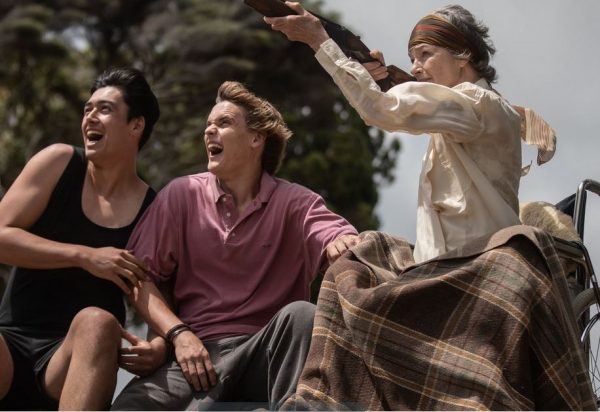
If nothing else, Ruth’s appearance in Sam’s world would strongly suggest this possibility. Even though they barely know one another upon her arrival, and despite the rocky start to their relationship, they find links that connect them. These bonds may not be the same as what one finds in a typical grandmother-grandson relationship, but the duo is definitely on the same wavelength for the most part. Both are radicals. Both are nonconformists. Both don’t care much for what others think of their views. And they both believe in playing by their own rules, particularly when it comes to enjoying life. One of the best examples of this comes when Ruth asks Sam if he has any friends, to which he says yes but adds that they’re mostly a rowdy, drunken lot, a response to which Ruth observes, “Sounds like my kind of people.”
Of course, despite the qualities they have in common, there are differences, too. Even though Ruth may be a little rough around the edges, she nevertheless insists on a certain degree of orderliness in her life, and she makes sure to convey these notions to Sam. For instance, she insists on buying him new clothes to give him a cleaner, neater appearance (an idea she sells by noting that the new look will give him better luck in attracting girls). Likewise, she’s miffed that the garden surrounding the farmhouse has been allowed to fall into disarray, so she talks Sam and his friends into making it more presentable (of course, she does this by bribing them with the promise of alcohol for their efforts). Some might question the wisdom of such practices, since they come with qualifiers (and somewhat questionable ones at that) to get them accomplished. But, if the tasks at hand get done and their importance sinks in for future reference, can she realistically be faulted for imparting these lessons in this way? The wisdom behind the carrot and the stick certainly springs to mind here, and it would appear to have a definite value when it comes to shaping new beliefs – and outcomes – going forward.
Sam is not the only beneficiary of this relationship, either. As Ruth witnesses his youthful exuberance, she realizes she can learn from that as well. Indeed, as someone who has led a challenging personal life, as well as a professional one in which she has seen firsthand the atrocities that humanity is capable of, the last thing she likely wants in her remaining days is to be saddled with health issues, a limited existence and condescending coddling. But, in watching how her grandson lives his life – and how he gradually goes out of his way to include her in it – she gets back some of that joy of living, partaking in fun, fulfilling activities that provide her with some of the sprightly pleasure that she relished in her younger days. It helps her feel more alive than she has in quite some time. And, with the flame of one’s life flickering ever less brightly, such an attitude can at least help to keep it burning longer than anticipated, providing much-needed light amidst the encroaching darkness.
Through all this, what we have here is an impressive act of co-creation, an inspiring, uplifting exercise in collaboration in which both protagonists participate. By pooling their energetic and belief resources, they manifest something beautiful and beneficial, a scenario in which circumstances help them attain what they were looking for and needed most. We’re all capable of doing the same when we work together harmoniously toward common ends. And, even if those ends may be a little out of the mainstream, as in this case, that doesn’t mean their materialization is any less likely when we put our minds to it.
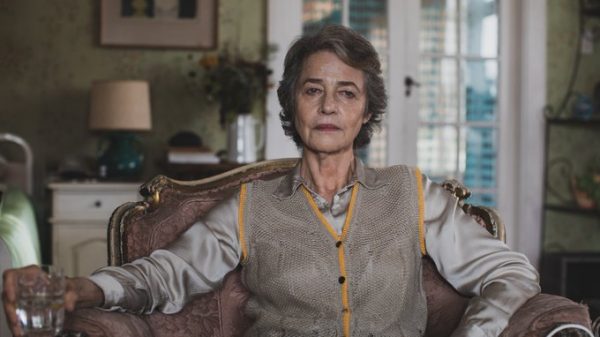
As “Juniper” so aptly illustrates, individuals seeking to sort out their personal challenges sometimes need to work together to achieve meaningful results. What’s more, strange as it may seem, these situations often call for the formation of unlikely pairings to attain desired outcomes, as writer-director Matthew J. Saville’s debut feature so eloquently demonstrates. In many ways, the relationship between Sam and Ruth is not the kind of connection that one would expect to develop under circumstances like these, a development that gives this story a fresh take on intergenerational relations. At the same time, however, the film’s occasional reliance on a somewhat predictable narrative line and its failure to allow its innate strength to come through as fully as it might have (particularly where the revelation of motivations is concerned) is a little disappointing. Nevertheless, those shortcomings are made up for by the picture’s gorgeous cinematography of rural New Zealand, as well as the excellent break-out performance of Ferrier and the positively outstanding portrayal of Rampling, who handily turns in some of the best work of her career here. “Juniper” may not fully live up to everything it could have been, but it has a lot going for it that’s well worthwhile, especially in its ability to move audience members as the story plays out. Enjoy what makes this moving comedy-drama work, and be sure to keep those hankies handy.
Copyright © 2023, by Brent Marchant. All rights reserved.

“Black Box” (“Boîte noire”) (2021 production, 2022 release). Cast: Pierre Niney, Lou de Laâge, André Dussollier, Sébastein Pouderoux, Olivier Rabourdin, Guillaume Marquet, Mehdi Djaad, Aurélien Recoing, Grégori Derangère, Anne Azoulay, Marie Dompnier, Octave Bossuet. Director: Yann Gozlan. Screenplay: Nicolas Bouvet, Yann Gozlan, Jérémie Guez and Simon Moutairou. Web site. Trailer.
We all have that little voice in our heads that we call “intuition.” We know it’s there, and sometimes its messages can be quite insistent. But how often do we actually listen to what it has to say? We frequently treat it dismissively, not taking it seriously. Since it lacks a certain tangibility, and because the content of its dispatches often defies logic and rationality, we tend to cast it aside, often at our own peril. However, there are ways to give it more credibility, such as when its messages are backed by physical evidence that bears out its contentions. Suddenly those once-dubious purely intangible notions take on a greater degree of plausibility, ideas genuinely worth heeding. Such is the experience of a gifted listener in the new French thriller, “Black Box” (“Boîte noire”).
Government aviation technician Mathieu Vasseur (Pierre Niney) has established quite a name for himself as a crash investigator. Thanks to his keen sense of hearing, he often uncovers evidence of the causes of these disasters that his peers overlook. That’s because this critical evidence is often auditory in nature, taking the firm of revealing sounds that are deeply buried within the aircrafts’ cockpit voice recorders (CVRs, devices more commonly called the planes’ “black boxes”) that are recovered after the crashes. Mathieu has become so proficient at this that he’s often looked upon as “the go-to guy” when these incidents occur.
However, when a plane on a flight from Dubai to Paris unexpectedly (and inexplicably) crashes, Mathieu is excluded from the investigation team. Mathieu is mystified by the decision, which is handed down to him by his supervisor, Victor Pollock (Olivier Rabourdin), who generally treats his associate as his right-hand man. Something doesn’t add up here, and Mathieu wants to know why the investigation is proceeding without his expertise.
In the ensuing days, circumstances take additional unexpected turns. Mathieu’s supervisor mysteriously disappears, a development that the aviation agency keeps quiet. Meanwhile, public pressure to find the cause of the crash grows, fueled by media speculation, particularly since there was no apparent reason for its downing. So what really happened?
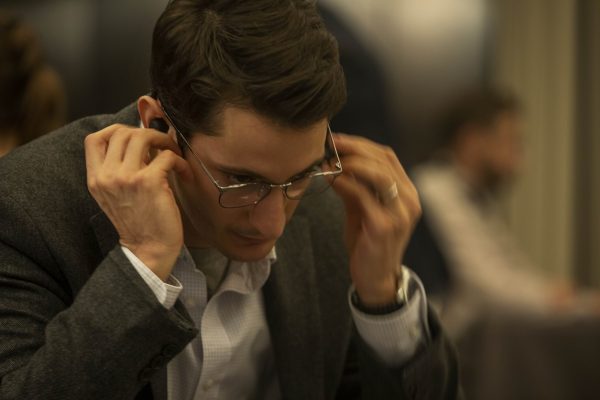
At this point, the head of the aviation agency, Philippe Rénier (André Dussollier), steps in and takes charge to expedite matters; as the boss, and with his supervisor nowhere to be found, he’s willing to take proactive measures to get to the bottom of things. He wants answers, and he’s at a loss to understand why Pollock didn’t appoint Mathieu to the team in the first place. So, in light of these developments and growing pressure to come up with an official explanation, Rénier assigns his gifted associate to the investigation.
The prevailing theory at the time Mathieu joins the investigation is that the aircraft was brought down by a terrorist on board the plane, based on black box recordings of inflammatory vocal rhetoric in the cockpit. And, on a cursory review, that confrontative audio would seem to support the working theory, something with which Mathieu initially concurs. He and Rénier subsequently appear at a press conference, hoping that this explanation will quell much of the public speculation. But does it?
Mathieu is not so sure of these findings, despite the blessing he appeared to have given it at the press conference. Upon further scrutiny, he begins stumbling upon disquieting evidence of other possible explanations, despite the apparent authenticity of the arguing that was recorded in the cockpit. And it’s that keen sense of hearing that begins tipping him off to other potentially plausible scenarios.
The possible causes that Mathieu uncovers are based on some rather far-fetched conclusions reached after applying his own unique investigatory techniques, especially the information he derives from interviews with a seasoned pilot, Alain Roussin (Grégori Derangère), who doesn’t have particularly kind things to say about the aircraft model in question. But, no matter how outlandish these alternate explanations may seem, they fit the evidence that steadily surfaces. And, the further Mathieu looks, it becomes quite troubling who might be involved in this scenario, including the head of the aircraft manufacturer, Claude Varins (Aurélien Recoing), the head of the company that designed the aircraft’s security systems, Xavier Renaud (Sébastein Pouderoux), and even Mathieu’s wife, Noémie (Lou de Laâge), a onetime government aircraft design analyst who has just landed a lucrative position with Varins’s firm.
When Mathieu presents his evidence to Rénier, the agency head is reluctant to agree with his associate’s findings. But, considering what Mathieu found, Rénier can’t bring himself to summarily dismiss the evidence out of hand. He gives Mathieu permission to keep digging, despite the fact that he knows the investigation might produce conclusions that could result in considerable blowback. But, when the duo considers what could be involved, they’re convinced that the truth must come out, no matter how damning it might be.
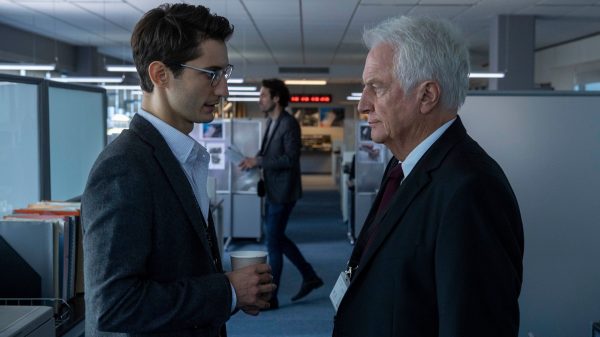
The implications in all this are staggering. In addition to revealing what may have actually happened to the plane, the question of Pollock’s unexplained disappearance remains. Then there’s Mathieu’s professional credibility, which could be ruined unless he receives backing from objective sources, such as a sympathetic journalist (Anne Azoulay) whose reporting could lend legitimacy to his cause. And, on a personal level, the future of Mathieu’s marriage is also at stake if he were to learn that his wife hasn’t been honest with him.
It’s a lot for Mathieu to process, especially when his life appears to be threatened, too. But, when he “hears” the truth – no matter how unconventional it may seem – can he realistically stay silent and deny it? What’s more, will the many challenges now surrounding Mathieu keep him from believing what he knows to be the truth – and what he must do to reveal it? The events that are unfolding may push him into making hard choices that his work has never prepared him for. Being willing to think unconventionally – including listening to intuitive insights that may be difficult to fathom and abide by – could prove to be essential to his salvation – and his very survival.
This becomes apparent as the crash investigation plays out. While the audio recordings and the intuitively derived beliefs that stem from them provide Mathieu with a good start, he must draw upon the leads provided by other intuitively based beliefs the further he gets into his inquiry. For example, as the once-uninvolved players in this story emerge from the shadows and step to the forefront, Mathieu must foster conclusions about their roles in this scenario by parceling together his findings and formulating beliefs about them in hopes that they’ll lead him to the answers he’s seeking. And, considering his proficiency at managing these beliefs, he’s truly capable at coming up with the evidence he needs to solve the mystery and to protect his own hide in the process.

Even when it comes to deciphering the thorny enigmas of this investigation, Mathieu has a knack for knowing how and where to look to find the evidence he needs. This becomes obvious when he delves into the disappearance of his supervisor. Like a skilled bloodhound, he follows his nose and picks up the scent of the proverbial trail. His intuition provides him with the beliefs he needs to lead him to clues that offer insight into Pollock’s role in the story, a revelation that subsequently unlocks a chain of additional valuable clues underlying the crash mystery.
Using intuition in situations like this is a skill we all innately possess, and Mathieu’s practice of it sets a fine example that we can all draw upon in unraveling the puzzles we face. Considering the multiple ways he employs it, he’s certainly become well-practiced in its use, and there’s no reason that we can’t do the same. However, there are several principles he draws upon in enhancing the effective use of this tool, and we’d be wise to follow suit.
For example, Mathieu obviously places tremendous faith in the value of his intuition, and that’s perhaps the most important enhancement principle to bear in mind. As noted previously, intuition is something that many of us treat skeptically, and that intrinsic doubt, in turn, can undermine its effectiveness. Indeed, if we treat it dismissively, we may lose out on the valuable input it can supply. That can be crucial when we’re faced with handling dicey situations, not unlike those that Mathieu experiences in terms of his credibility and personal safety as this story unfolds.
Likewise, Mathieu has overcome the fears and limitations that are often associated with openly employing tools that may be regarded as unconventional or even preposterous. Oftentimes, when we draw upon resources that are prone to ridicule, we may be hesitant to make use of them to the extent we could, if at all. Not only could that hinder our effectiveness at uncovering the solutions we seek, but it could also put us in jeopardy, personally and professionally. To his credit, Mathieu has no hesitation to make the most of his intuition and what it can do for him, advice we’d be wise to follow.
If nothing else, Mathieu’s experience illustrates that our intuition is nothing to be underestimated, even if it’s something that often takes a back seat to our intellect. While our intellect certainly shouldn’t be undervalued, the same should be said for our intuition as well. Indeed, if it served no purpose, then why do we possess it? It deserves equal treatment at the very least, especially when we’re willing to see what it can do for us. That’s important when the stakes are high, as is the case here. With so much on the line, hearing truly could be believing.

When it comes to this picture, the first thought that comes to mind for me is, “Talk about a helluva movie!” Writer-director Yann Gozlan’s stylish, suspenseful thriller follows a plane crash investigation conducted by a diligent, talented aviation technician whose dogged determination won’t let him stop, particularly when a number of suspicious smoking guns begin turning up, some of which hit close to home and begin placing his credibility, and even his personal safety, in danger. Despite a slight tendency to drag a bit in the second hour, this contemporary noir-esque offering gets virtually everything else right. Its inventive cinematography, excellent film editing, engaging soundtrack and fine performances mesh perfectly, and the slow-simmering pace is ideal as clues are meticulously doled out in carefully measured parcels, much like what one might find in the pictures of Alfred Hitchcock, Brian DePalma and Roman Polanski. In fact, in many ways, the structure of this release is strongly reminiscent of Polanski’s chilling and captivating slowburn thriller, “The Ghost Writer” (2010), a comparable edge-of-your-seat offering, to be sure.
For its efforts, “Black Box” captured five 2022 nominations at the Cesar Awards, the French equivalent of the Oscars, with nods for best actor, screenplay, music, sound and editing. In light of its accolades and popularity in France, I’m truly mystified why this picture hasn’t received wider attention or distribution domestically, having played in extremely limited theatrical release in 2022. Thankfully, though, it’s now available for streaming online and home media. If you’re looking to watch something that will hook you and take you on a spellbinding thrill ride, give this one a look; you won’t regret it.
They say that “seeing is believing,” but, as this film so clearly shows, it’s a principle not limited to our visual sense. However, in this case, I’m not talking just about one’s auditory capabilities; I’m also referring to the value of that so-called sixth sense that we all possess but tend to ignore. Our intuition truly merits the same recognition and attention as the other five senses that we take for granted and unquestioningly make use of when it comes to understanding and appreciating our world. And, when we sincerely see what that sixth capability can do for us, we just might be willing to elevate the level of its importance. That could reshape how we view our existence and how it patently manifests, providing new insights that truly could make us committed believers.
Copyright © 2023, by Brent Marchant. All rights reserved.

“A Life’s Work” (2020 production, 2023 release). Cast: Jill Tarter, Robert Darden, David Milarch, Jared Milarch, Paolo Soleri, Jeff Stein. Archive Footage: Frank Lloyd Wright. Director: David Licata. Web site. Trailer.
Many of us have trouble seeing into the future, sometimes no more than just a week or so in advance. That lack inherently leaves us wondering what’s next and how to plan for it. As a result, we often tend to go from moment to moment, unaware of what awaits us around the corner until we actually find ourselves in the midst of it. But not everyone operates that way; some of us have the foresight to imagine our world far down the road with elements that reflect our vision for what could lie ahead. This is particularly true when it comes to what we want to accomplish in our lives. The goals in these instances can be quite ambitious, too, frequently involving undertakings that will take a long time to fulfill, sometimes even extending beyond the lengths of our lifetimes. And it’s ventures like these that provide the focus for the inspiring new documentary, “A Life’s Work.”
What do searching for evidence of extraterrestrial life, an African-American gospel music preservation program, a revolutionary architecture project and an organized effort to clone legacy trees have in common? They’re the undertakings profiled in director David Licata’s impressive, uplifting new film. All four of them were launched and managed by individuals who were willing to take a long-term view toward their execution and fulfillment, perhaps for a duration that would likely exceed their own natural lives. They represent projects that many of us would probably look on as unduly daunting and perhaps even hopelessly impractical, especially given that we might never be able to see them completed. However, considering the importance that these innovators attached to these endeavors, they couldn’t bring themselves to step away from them, even if there was a chance that they’d never see them reach their hoped-for conclusions.
Such dedicated efforts thus genuinely represent the chosen life’s work of the visionaries who initiated them. It should go without saying that the commitment required for these undertakings was undeniably substantial, often involving many considerations that went beyond the immediate needs of achieving the desired outcomes. Documenting these endeavors also required a comparable commitment from the filmmaker, who spent 15 years recording the work that went into these enterprises. But, when one considers that the life’s work of these individuals is involved, it should come as no surprise that it would take such a protracted time to bring the record of their efforts into being. And, even with that kind of commitment, it’s not outside the realm of believability to say that the cinematic recounting of these stories itself remains fundamentally incomplete, even after all that time.
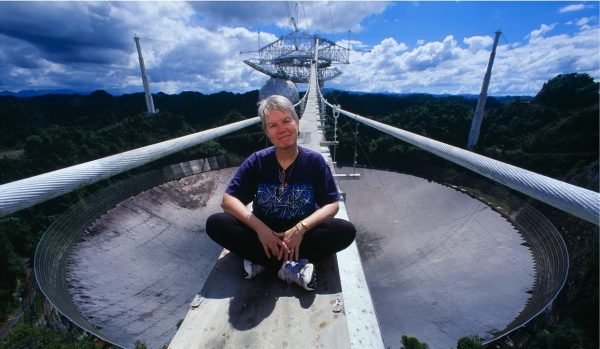
The range of ventures examined in the film is quite diverse, not to mention truly impressive in scope. For starters there’s the work of Jill Tarter, longtime (and now-former) head of SETI, the Search for Extra Terrestrial Intelligence project. This former government-funded program (now supported by private financing) searches the heavens for evidence of life beyond our planet by recording and interpreting radio telescope signals, all in hopes that they might provide clues about what – or who – may be out there. Admittedly, this could represent a long shot attempt at making contact, but, as Tarter maintains, is that any reason not to look? Should this effort pay off, it could open the door to one of the greatest scientific discoveries of all time. That seems to be a worthwhile outcome, no matter how heavily the deck may seem to be stacked against us.
Closer to home but no less important, there’s the effort of Robert Darden to save a portion of our artistic heritage that’s in danger of being lost forever. As the founder of the Black Gospel Music Restoration Project, Darden has earnestly sought to preserve the rapidly disappearing recordings of African-American gospel musicians from years past. According to Darden, an estimated 75% of these recordings has already vanished, never to be recovered. Because of this, he has made it his mission to scour private collections, vinyl record store inventories and other sources to find these works before they’re gone and to secure their transfer to electronic versions so that they may be preserved for posterity.
Preservation is also the theme behind the work of David Milarch and his son, Jared, who, through the Champion Tree Project, have worked tirelessly to collect the DNA of endangered legacy species, such as the American elm and the California redwood, so that it can be replicated to produce viable new saplings. Their hope is to restore the populations of these vanishing species so that future generations may enjoy them. And, given the ecological and potential medicinal applications of these trees, the Milarchs also hope that the preservation of these species can benefit mankind in ways that extend beyond their sheer horticultural beauty.
Just as the Milarchs’ legacy tree preservation efforts are aimed at benefitting our future well-being, so, too, does the ongoing work of architect Paolo Soleri, who spent years constructing his innovative designs prior to his death in 2013. Soleri, a onetime protégé of iconic architect Frank Lloyd Wright, is credited with founding the “arcology” movement, a discipline aimed at fusing the principles of architecture and ecology. Given what he saw as the squandering of resources and land associated with suburban sprawl, Soleri focused his efforts at creating ecologically friendly architectural designs characterized more by “building up” rather than “building out.” He subsequently created a number of designed communities to reflect these notions. Over the past five decades, Soleri and his followers have worked on constructing the first of these communities, the experimental town of Arcosanti, AZ, about 70 miles north of Phoenix. Progress has been slow but steady over the years, with Soleri’s work taken over by protégés like Jeff Stein and his colleagues in the time since the creator’s passing. It’s hard to say whether the work on this community will ever be finished, but, as Stein observes in the film, when is any community ever truly finished? It’s a work in progress, one that reflects the life’s work of not only its originator, but also of those who share his vision and seek to carry on with it.
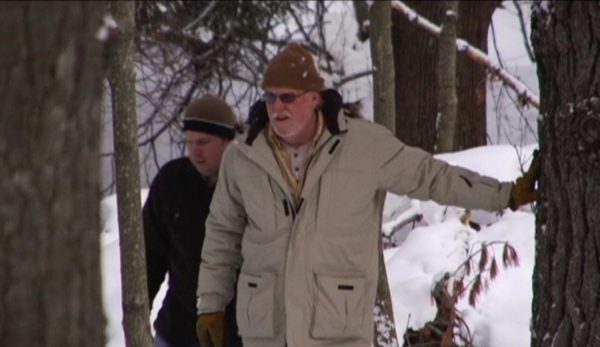
That last statement essentially embodies the mindset of those who initiated and have continued projects like these and others. Those charged with carrying out these efforts unquestionably see them as their life’s work, and they make no apologies for it, regardless of how critically others might view them. Were it not for individuals like this, however, we might not have realized many of the accomplishments that have been achieved in many fields of endeavor. Perseverance, it would seem, does win in the long run.
Considering the immense scope behind these projects, one might legitimately wonder why anyone would be willing to take them on. But, in these cases (and virtually any others like them), the answer is likely to be the same in each instance – because those embracing them believe that they can be accomplished. It doesn’t matter to them how long it would take, even if they don’t live long enough to see their completion. They believe in the value and viability of these ventures, no matter what, even if some might see them as pursuing Quixotic causes. Rather, these dedicated innovators simply look upon their work as big tasks that need to be tackled for the betterment of humanity.
The beliefs driving these pursuits are quite potent, to be sure. But, as anyone who incisively understands the nature of beliefs knows, they’re powerful and persistent resources. And, when backed by sufficient resolve and faith, they’re tremendous tools that can enable us to accomplish almost anything. Such are the end products of the conscious creation process, the philosophy that maintains we can employ these resources to create the reality we experience, including all of the elements within it. This is not to suggest that such materializations can spontaneously manifest into existence with the snap of one’s fingers, but they can plant the seeds that lead to the sprouting of what they’re ultimately intended to create. The driving forces behind the projects examined in this film may not have heard of this school of thought, but it’s obvious they have conviction behind their beliefs and have mastered the principles that make this philosophy work.
Regardless of how quickly or thoroughly these creations manifest, those seeking to bring them into being nevertheless are convinced they’re achievable. That’s apparent by how long they have allowed themselves to remain committed to their fulfillment. Paolo Soleri, for example, believed in the veracity of the Arcosanti community and continued to work on its development even when faced with severe funding issues. To keep his dream alive, he developed workarounds, such as recruiting volunteer crews to construct the buildings that eventually materialized, despite the obstacles that slowed their progress. He also devised a unique way to raise money by crafting wind bells that were sold in galleries and gift shops to generate much-needed cash. These measures may not have been solutions that immediately sprang to mind to keep the project going, but they worked nonetheless, and belief in their viability ultimately proved correct.

That kind of thinking has also been driving the SETI project, even though it has yet to produce the definitive proof of its core mission. According to Jill Tarter, the program has experienced issues not unlike what Soleri confronted with the Arcosanti project, namely, maintaining a steady flow of funding. To that end, Tarter has said that one of her chief roles in SETI was to serve as its “head cheerleader,” enthusiastically drawing attention to the cause, the value of its purpose and the need to raise money to keep it going. In many ways, her efforts echoed those of Dr. Ellie Arroway (Jodie Foster) in the 1997 sci-fi offering “Contact” in which a plucky astronomer passionately endeavors to keep her extraterrestrial search program alive at a time when many others were convinced it was foolhardy nonsense, an outcome disproved by the results it ultimately achieved. One could say that Tarter forged ahead with that same kind of optimism and commitment when she headed the real-world version of that program. And her belief in it just may prove correct someday as well.
While the Arcosanti and SETI programs are seeking to chart new ground, the Black Gospel Music Restoration Project and the Champion Tree Project are aimed at preserving creations that are in danger of becoming lost. Because of what could occur to these commodities without adequate attention, the value of preservation-based programs like these is just as great as that behind the aforementioned groundbreaking endeavors. However, even though these projects are not exploring new territory, that’s not to say that the effort required to fulfill them is any less great, which means that the power of the beliefs driving them must also be just as significant.
Robert Darden and David and Jared Milarch understand this, and they employ this thinking in their respective undertakings. They also have a realistic sense about what may or may not be attainable. through their efforts Darden, for example, understands that not every legacy recording can be saved, as evidenced by the loss of 75% of such works that has already occurred. Likewise, the Milarchs appreciate the fact that a number of the legacy trees they pursue no longer possess viable DNA that can be used for cloning, despite the continued existence of specimens of these species. But, then, Darden and the Milarchs don’t let these potential shortcomings deter them in their efforts. As Darden observes in one of his interview segments, the gospel music restoration project may not be able to save everything, but he can take satisfaction from every one of the recordings that it is able to preserve. That’s an accomplishment in itself, even if it doesn’t represent the totality of what had been created at one time. It’s a principle that anyone seeking to preserve any kind of commodity from becoming lost can take pride in, regardless of what’s at stake.

No matter how much progress is made on projects like these, the fact that they continue, with beliefs underlying and supporting such perseverance, deserves meritorious recognition, particularly for the dedication of those carrying them out. These efforts, in fact, serve to validate the very essence of the power and persistence of our beliefs, and this film celebrates that notion. Let’s hope we never lose sight of that, no matter what projects we may choose to undertake.
How inspiring it is to see committed individuals embark on Herculean tasks like these, even if just for the sheer passion they engender and what they can ultimately contribute to the well-being of mankind. Filmmaker David Licata, who spent 15 years following four such ventures, provides an insightful look at these projects and the implications behind their execution. In telling these stories and assessing the efforts of their progenitors, the director examines not only the particulars behind these endeavors, but also the motivations and commitments driving their creators, as well as the challenges associated with carrying out these undertakings. The film presents a balanced view of each of these projects, told economically and on point, without extraneous padding or irrelevant material, a refreshingly welcome relief considering how many less-than-satisfying recent documentaries have been put together. What’s most significant about this offering, though, is the inspiration that it prompts among viewers. Audience members are treated to a variety of illustrations that truly depict what constitutes “a life’s work” in every sense of the expression. It’s quite uplifting to see what our visions and beliefs can yield, and this film brings that notion front and center for all to see.
Taking the long-term view toward a project can indeed be overwhelming, especially since there’s no definitive guarantee of seeing any reward coming from it. But is that the only reason behind tackling such pursuits? If we were to adopt such a view, it’s likely that much of what mankind has accomplished may have never been realized. Rewards are truly satisfying outcomes to emerge from such efforts, but they shouldn’t be viewed as the starting point for taking on such challenges. If a venture has true value, the rewards will likely result anyway. It’s the work itself that matters, and, when it’s backed by the power of the right mix of beliefs, tremendous outcomes are possible. And that should be the most rewarding aspect to come out of all this.
Copyright © 2023, by Brent Marchant. All rights reserved.